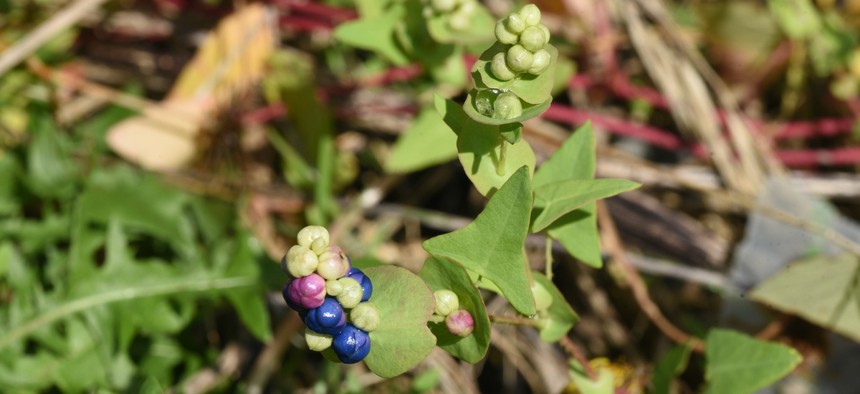Invasive Weed Found in Michigan Grows Six Inches a Day

The plant has light green triangular leaves, and both the stems and leaf blades have recurved barbs that help it climb over—and smother—other vegetation. Shutterstock

Connecting state and local government leaders
The mile-a-minute weed, discovered at a nature center in Albion, can persist in the soil for up to six years.
Doug White was walking at a nature center in Albion, Michigan, scouting for house wrens, when he noticed the barbed vine.
White, a professor of ecology at Albion College, was curious about the plant’s purple and blue fruits. He’d written his dissertation on plant life that spreads through bird droppings (“bird-dispersed fruits”) and wanted to identify the vine, so he snapped a photo and did some research. And then he contacted the Michigan Department of Natural Resources.
His discovery was not a happy one. The plant is an invasive species known as mile-a-minute weed, a fast-growing barbed vine native to India, Asia and the Philippines. It was first discovered in the United States in a Pennsylvania nursery in the 1930s, likely brought there hidden in the soil of other nursery stock. It has since spread to 15 states, as far west as Oregon but primarily in the Midwest and Northeast.
Those existing infestations are small, far apart and likely spread by animals, as the fruit is attractive to birds, deer and other small mammals, said Joanne Foreman, invasive species communications coordinator for the Michigan Department of Natural Resources.
“Where it’s dispersed across the U.S. so far, it’s in little patchy areas, but they’re quite far away from each other,” she said. “Because of that distance, it’s probably mostly birds, but we know that deer and squirrels will eat it too, which helps spread it around in local vicinities.”
White’s discovery of the vine—a small patch at the edge of the nature center on Albion College’s campus—is the first known sighting in Michigan. DNR officials are working to determine whether it’s taken root elsewhere, a process that starts by issuing a press release that asks people to check their property and contact the agency if they find any vines.
Staff members work to verify those reports, map the distribution and then formulate what Foreman calls a “larger plan of attack” to manage and eradicate the plant. Because the vine grows fast—up to 6 inches in a single day, or 25 feet in six to eight weeks—spreading the word quickly is important. Left unchecked, the vine could have serious ramifications for the state’s Christmas tree farms, among other things.
“It grows so quickly and tries to stay in the sun, so it uses trees to get closer to the light, and it just smothers them,” Foreman said. “We mention Christmas tree farms specifically because Michigan has so many of them, but it’s also a problem for reforestation projects or any sort of construction. If a bird or deer drops those seeds into an open space like that, you might end up spending time and money fighting this plant.”
Seeds from the vine can persist in the soil for up to six years, so mitigation measures typically involve pulling the plants up by hand and then watching for regrowth. The Albion patch will be managed by staff at the nature center and overseen by botanists and faculty members.
If subsequent plants are discovered on public land, state officials can handle them; if they’re found on privately owned property, mitigation measures depend entirely on the owner. Because the plant is only on the state’s invasive species watch list, there’s no mechanism to mandate or enforce treatment or removal, Foreman said. But, in most cases, people are cooperative.
“With new things, there’s this sort of discovery attitude if someone thinks that they’ve found it, and they’re generally very happy to help manage it—unless it’s something pretty that they want to keep,” she said. “And in this case, this is not a pretty plant that most people would want to keep.”
Kate Elizabeth Queram is a staff correspondent for Route Fifty and is based in Washington, D.C.

NEXT STORY: Puerto Ricans Voted in Favor of Statehood. What Happens Now?




